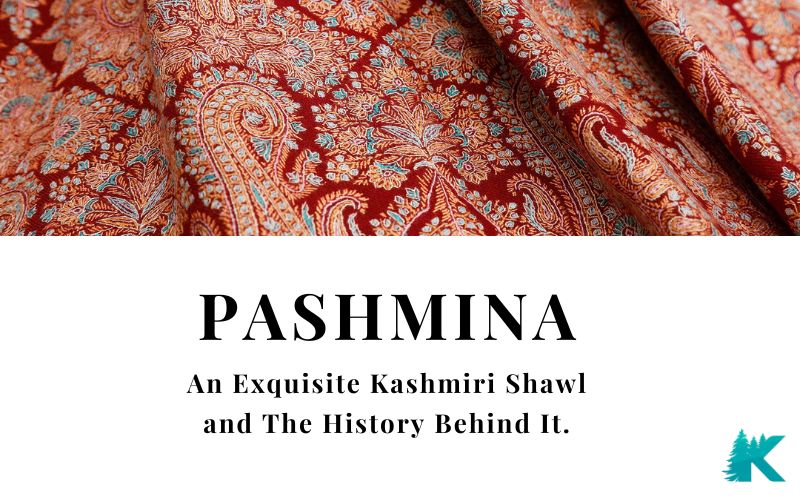Blog
The Luxurious Craft of Pashmina

Defining the heritage of Kashmir, handicrafts prevail with much ardor and luxury. Each handicraft belongs to the realm of paradise. Alongside the horizons of Kashmir Valley, the handicrafts reflect the songs of traditions and culture. The luxurious craft of Pashmina is the handicraft of fortitude which is blessed with the high skill of artisans. Artisans write the song of heritage on each Pashmina Shawl to witness the culture through the eyes of Kashmir.
How is the Finest Cashmere procured?

Cashmere wool is obtained from several breeds of goats like Australian Cashmere Goat, Liaoning, Inner Mongolia, Xinjiang, Hexi, Zhonghwei, Tibetan Plateau, and Luliang breeds. While Pashmina is the finest Cashmere wool procured from Changhthanghi Goats. These goats are from a rare species of Goats only found at the feet of Changhthanghi mountain, Ladakh. It is 12 to 16 microns in diameter. Thus, termed the high grade of fineness.
Changthangi Goats or Changra Goats develop a thick layer of wool under their belly, behind the ears and near their neck to protect them from colds of high altitude that go to more than -50°C in winter. Eventually, when the summer season arrives, the Goats rub against rocks and trees to get rid of the excess wool. In addition, Changpa tribe herders manually comb out the excess wool to make the Goats feel the fresh air of summer. This is how the finest Cashmere wool is procured which is called Pashmina. Also, there is no harm to the animals which is evident in the process of procurement.
The Crafting Begins in Kashmir Valley

After the combing out of Pashmina wool from Changra Goats, it is packed in small packets and transferred to the Valley of Kashmir for the craft to begin. On reaching the Kashmir Valley, the artisans applaud its arrival and began the first and foremost step called Cleaning of Pashmina wool. Pashmina wool is cleaned thoroughly to remove all the grime from it. Afterwards, the cleaned Pashmina Wool is transferred to the households of Kashmir to begin the step of Spinning.
Spinning is the process of transforming Pashmina wool to fine Pashmina yarns. It is done on a spinning wheel called “Yinder” in the local language. Mostly, the womenfolk of Kashmir do this step of Spinning. They gather their spinning wheel and start the Spinning process alongside humming the Kashmir folklore called “Wanvun”.
Afterwards, the Pashmina yarns are transferred to the workshops called “Karkhanas” in the local Language. In workshops, a handloom made of forest wood is set up to accomplish the next step of crafting called Weaving.
Weaving is the transformation of Pashmina yarns to Pashmina Shawl. Artisans work manually on handlooms using hands and feet to craft a Pashmina Shawl with diligence and precision. There is a definite aura of workshops that speaks of Pashmina and its legacy through the sound of handloom.
Designing the Pashmina Shawl

Pashmina Shawls are thereby moved on to the next process of Designing. Several ways of designing are there in the realm of Pashmina Craft. The Pashmina Shawl crafted is of its colour, the colours of Pashmina wool which are called khud-rang in the local language meaning self-colour. Therefore, to add the tinges of colours, Pashmina Shawl is tinctured in the place of Dyers or “Rangurs”. They sort the different shades and dye the Pashmina Shawl as required.
Afterwards, there is the process of designing prescribed. For Hand-Embroidered Pashmina, there is hand-block printing done and then Hand-embroidery is intricately cast on the designs by prolific artisans of the Valley of Kashmir.
Likewise, there is designing given in the process of Weaving by interweaving the warps and wefts on a map of designs called “Taleem”. This is how a Kani Pashmina Shawl is crafted. Several designs include giving patterns in weaves.
In nutshell, designing a Pashmina Shawl is a beautiful process to relish the heritage and traditions all along the Pashmina Shawl.
History of Pashmina
A Persian saint by the name of Mir Syed Ali Hamdani was travelling the world with his 800 craftsmen, preachers and scholars to preach the holy message of Islam. On his journey towards Kashmir, he landed in Changhthanghi Ladakh. While he was resting on the foot of the mountain, he saw a Goat. When he touched its wool, he was astonished to feel the softness and fineness of the wool. He combed some wool out from it and made a pair of socks. The warmth and softness of the socks made him feel bliss.
Afterwards, on reaching Kashmir, he gifted the same pair of socks to the ruler of Kashmir, Zain-ul-Abideen. The saint suggested the ruler make a workshop to craft the Ladakhi Goat wool to make accessories of warmth and fineness. The craftsmen from the Middle East who were accompanying the saint taught the crafting to the people of Kashmir. From then till now, the Pashmina Craft is filled in the heritage of Kashmir like its own as the skill of artisans made evident that people of Kashmir belong to craft Pashmina.

Kashmers.com adorns you with Pashmina Shawls of elegance
Kashmers.com adorns the craft of Pashmina for you to make a journey from the 13th century to this today. We ethically procure the finest Cashmere called Pashmina and craft it in Kashmir by the most skillful artisans to make the beauty of heritage flourish towards the handicrafts of Kashmir. There is the supplication of adding contemporary designs for Gen Z to make you relish the elegance and luxury of every piece of Pashmina Shawls.



